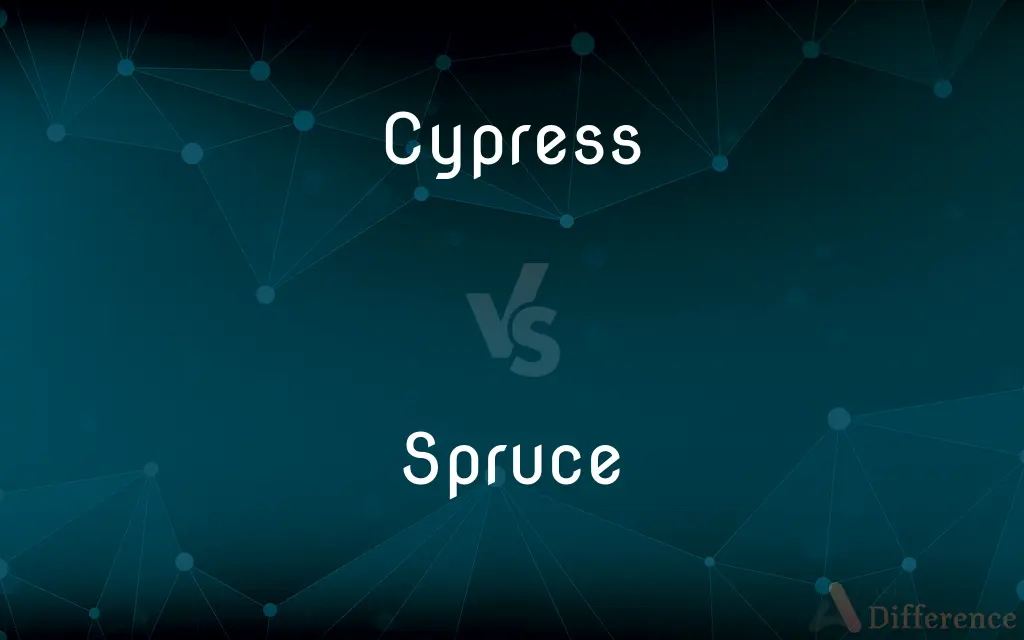Cypress vs. Spruce — What's the Difference?
Edited by Tayyaba Rehman — By Maham Liaqat — Updated on March 11, 2024
Cypress trees are known for their distinctive, conical shape and durable, rot-resistant wood, ideal for outdoor uses, while Spruce trees are valued for their straight, tall growth and versatile wood used in construction and musical instruments.

Difference Between Cypress and Spruce
Table of Contents
ADVERTISEMENT
Key Differences
Cypress trees, belonging to the family Cupressaceae, are noted for their longevity and hardy nature, often found in warm climates and wetlands. They are characterized by their unique conical shape, flared bases, and scale-like leaves, with some species known for developing "knees" from their roots for stability and gas exchange. On the other hand, Spruce trees, part of the family Pinaceae, are known for their tall, straight growth, making them a favorite in the timber industry. Spruce wood is light yet strong, with a fine, even grain that makes it suitable for a wide range of uses, including construction, paper production, and particularly in making musical instruments like violins and guitars, where the wood's resonant qualities are valued.
Cypress trees often have a more varied habitat, with species adapted to different environments, from coastal marshes to mountainous areas. Their adaptability contributes to their diverse uses, from ornamental landscaping to ecosystem support in wetland areas. Spruce trees, commonly found in colder, northern climates, form dense forests and are integral to their ecosystems, providing habitat and food for wildlife. The uniformity of spruce makes it ideal for lumber and paper products, contributing significantly to the forestry industry.
The maintenance and care of cypress trees can vary based on the species and growing conditions, with some requiring minimal care once established, especially those native to wetlands and flood-prone areas. Spruce trees, adapted to cooler climates, generally require well-drained soil and full sun, and are susceptible to certain pests and diseases, such as spruce beetle infestations, which can necessitate preventive and management measures.
Culturally, both cypress and spruce trees hold significance in various traditions and applications. Cypress trees have been associated with mourning and are often found in cemeteries, symbolizing eternal life, while spruce trees are popularly used as Christmas trees, celebrated for their symmetrical shape and evergreen qualities.
Understanding the distinctions between cypress and spruce trees is crucial for horticulture, forestry, and landscaping decisions, reflecting the importance of selecting the right species for specific needs, environmental conditions, and desired outcomes.
ADVERTISEMENT
Comparison Chart
Family
Cupressaceae
Pinaceae
Climate Adaptation
Warm climates and wetlands
Colder, northern climates
Wood Characteristics
Durable, rot-resistant, ideal for outdoor use
Light, strong, versatile, used in construction and musical instruments
Growth Habit
Conical shape, flared bases, scale-like leaves
Tall, straight growth, needle-like leaves
Uses
Fencing, decking, exterior construction, landscaping
Lumber, paper products, musical instruments, Christmas trees
Maintenance
Varies by species, some require minimal care
Requires well-drained soil, susceptible to pests
Cultural Significance
Associated with mourning and eternal life
Popular as Christmas trees
Compare with Definitions
Cypress
Thrives in a wide range of environments.
The cypress tree adapts well to both dry hills and wetlands.
Spruce
Valued for its straight, tall growth.
Spruce trees are extensively harvested for their high-quality timber.
Cypress
Known for rot-resistant wood.
Cypress wood is a top choice for outdoor furniture due to its durability.
Spruce
Preferred for resonant qualities.
The violin maker chose spruce for its excellent sound transmission.
Cypress
Popular in landscaping for aesthetic appeal.
The landscaped garden featured a majestic cypress as a focal point.
Spruce
Commonly used as Christmas trees.
The family chose a tall spruce for their Christmas tree this year.
Cypress
Plays a crucial role in wetland habitats.
Cypress trees provide critical support to wetland ecosystems by stabilizing soil and water.
Spruce
Thrives in cooler regions.
Spruce forests dominate the landscape in many northern territories.
Cypress
Conical shape with flared bases.
The cypress's distinctive knees are a unique adaptation to swampy lands.
Spruce
Prone to spruce beetle infestations.
The spruce trees in the area were being treated for beetle damage.
Cypress
Cypress is a common name for various coniferous trees or shrubs of northern temperate regions that belong to the family Cupressaceae. The word cypress is derived from Old French cipres, which was imported from Latin cypressus, the latinisation of the Greek κυπάρισσος (kyparissos).Species that are commonly known as cypresses include: Most prominently: Cypress (multiple species within the genus Cupressus)Otherwise: The family Cupressaceae also contains 13–16 other genera (not listed above) that do not bear cypress in their common names.
Spruce
A spruce is a tree of the genus Picea , a genus of about 35 species of coniferous evergreen trees in the family Pinaceae, found in the northern temperate and boreal (taiga) regions of the Earth. Picea is the sole genus in the subfamily Piceoideae.
Cypress
An evergreen coniferous tree with small rounded woody cones and flattened shoots bearing small scale-like leaves.
Spruce
Any of various coniferous evergreen trees of the genus Picea, having flattened or four-angled needlelike leaves, a conic shape, pendulous cones, and soft wood often used for paper pulp.
Cypress
Any of various evergreen trees or shrubs of the genus Cupressus, native to Eurasia and North America and having opposite, scalelike leaves and globose woody cones.
Spruce
Any of various similar or related trees.
Cypress
Any of several similar or related coniferous trees, such as the bald cypress.
Spruce
The wood of any of these trees.
Cypress
The wood of any of these trees.
Spruce
A grayish green to dark greenish black.
Cypress
Cypress branches used as a symbol of mourning.
Spruce
Neat, trim, and smart in appearance
"a good-looking man.
Spruce and dapper, and very tidy" (Anthony Trollope).
Cypress
An evergreen coniferous tree with flattened shoots bearing small scale-like leaves, whose dark foliage is sometimes associated with mourning, in family Cupressaceae, especially the genera Cupressus and Chamaecyparis.
Spruce
To make neat and trim
Spruced up the chairs with new slipcovers.
Cypress
A coniferous tree of the genus Cupressus. The species are mostly evergreen, and have wood remarkable for its durability.
Spruce
To make oneself neat and smart in appearance
He was sprucing for the school dance.
Cypress
Wood of any of various cypress trees especially of the genus Cupressus
Spruce
Any of various large coniferous evergreen trees or shrubs from the genus Picea, found in northern temperate and boreal regions; originally and more fully spruce fir.
Cypress
Any of numerous evergreen conifers of the genus Cupressus of north temperate regions having dark scalelike leaves and rounded cones
Spruce
(uncountable) The wood of a spruce.
Spruce
(used attributively) Made of the wood of the spruce.
That spruce table is beautiful!
Spruce
(obsolete) Prussian leather; pruce.
Spruce
(comparable) Smart, trim, and elegant in appearance; fastidious (said of a person).
Spruce
To arrange neatly; tidy up.
Spruce
To make oneself spruce (neat and elegant in appearance).
Spruce
To tease. en
Spruce
Any coniferous tree of the genus Picea, as the Norway spruce (P. excelsa), and the white and black spruces of America (P. alba and P. nigra), besides several others in the far Northwest. See Picea.
Spruce
The wood or timber of the spruce tree.
Spruce
Prussia leather; pruce.
Spruce, a sort of leather corruptly so called for Prussia leather.
Spruce
Neat, without elegance or dignity; smart; trim; - formerly applied to things with a serious meaning; now chiefly applied to persons.
Spruce
Sprightly; dashing.
He is so spruce that he can never be genteel.
Spruce
To dress with affected neatness; to trim; to make spruce; - often used with up; as, to spruce up the house for Company.
Spruce
To dress one's self with affected neatness; as, to spruce up.
Spruce
Light soft moderately strong wood of spruce trees; used especially for timbers and millwork
Spruce
Any coniferous tree of the genus Picea
Spruce
Make neat, smart, or trim;
Spruce up your house for Spring
Titivate the child
Spruce
Dress and groom with particular care, as for a special occasion;
He spruced up for the party
Spruce
Marked by smartness in dress and manners;
A dapper young man
A jaunty red hat
Common Curiosities
What makes spruce trees popular for musical instruments?
The uniform grain, light weight, and strength of spruce wood contribute to its resonance and sound quality, making it a preferred choice for instruments like violins.
How do cypress trees contribute to their ecosystems?
Cypress trees play a vital role in stabilizing soil, providing habitats, and supporting diverse wetland ecosystems.
Are all cypress trees suited for wetland areas?
Many cypress species thrive in wetlands, but some are adapted to drier conditions, underscoring the importance of species selection based on the environment.
How do cypress "knees" benefit the tree?
Cypress "knees" may help in providing stability in swampy soil and facilitate gas exchange in flooded conditions.
Can spruce wood be used for outdoor construction?
While spruce wood is versatile, its susceptibility to moisture and decay without treatment makes it less ideal for outdoor construction compared to more durable woods like cypress.
Is spruce or cypress better for landscaping?
The choice depends on climate, soil conditions, and desired aesthetic, with cypress often preferred for its distinctive shape and spruce for its classic evergreen look.
How fast do cypress trees grow?
Growth rates vary among cypress species, with some growing relatively fast, offering quick landscaping benefits.
Can cypress wood be used indoors?
Yes, cypress wood's durability and aesthetic appeal make it suitable for indoor uses, including paneling and flooring.
What are the challenges in growing spruce trees?
Challenges can include susceptibility to pests like the spruce beetle, and the need for cooler climates and well-drained soils.
Are spruce trees affected by climate change?
Like many species, spruce trees can be impacted by climate change, affecting their growth patterns and susceptibility to pests.
Share Your Discovery

Previous Comparison
Platform vs. Environment
Next Comparison
Thereat vs. ThereinAuthor Spotlight
Written by
Maham LiaqatEdited by
Tayyaba RehmanTayyaba Rehman is a distinguished writer, currently serving as a primary contributor to askdifference.com. As a researcher in semantics and etymology, Tayyaba's passion for the complexity of languages and their distinctions has found a perfect home on the platform. Tayyaba delves into the intricacies of language, distinguishing between commonly confused words and phrases, thereby providing clarity for readers worldwide.













































